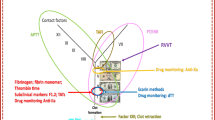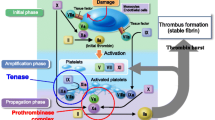Abstract
To simplify and optimize oral anticoagulation, new target-specific oral anticoagulants (TSOAs) have been developed. The direct thrombin-inhibitor dabigatran and the direct factor Xa inhibitors rivaroxaban, apixaban and edoxaban are the first such compounds to receive approval in certain countries for various indications. Due to the predictable pharmacokinetic and pharmacodynamic profiles of these drugs, routine monitoring of patients receiving TSOA therapy has not been considered necessary. However, it has now been realized that in routine clinical settings, there are several situations where it may be prudent to assess the level of TSOA anticoagulation. Several studies evaluating the influence of TSOAs on various coagulation assays have been performed to identify systems that can be used to monitor these drugs. With a particular focus on dabigatran and rivaroxaban, we will describe and discuss the potential of several methods for measuring the anticoagulant effect of TSOAs, as well as their methodological limitations and the restrictions in transferring their results into clinical context.

Similar content being viewed by others
References
Bingham JB, Meyer OO, Pohle FJ et al (1941) Studies on hemorrhagic agent 3,3′-methylenebis (4-hydroxy-coumarin): I. Ist effect on the prothrombin and coagulation time of the blood of dogs and humans. Am J Med Sci 202:563–577
Ageno W, Gallus AS, Wittkowsky A et al (2012) Oral anticoagulant therapy: antithrombotic therapy and prevention of thrombosis, 9th ed: American college of chest physicians evidence-based clinical practice guidelines. Chest 141(2 Suppl):e44S–e88S
Patel MR, Mahaffey KW, Garg J et al (2011) Rivaroxaban versus warfarin in nonvalvular atrial fibrillation. N Engl J Med 365(10):883–891
Conolly SJ, Ezekowitz MD et al (2009) Dabigatran versus warfarin in patients with atrial fibrillation. N Engl J Med 361(12):1139–1151
Granger CB, Alexander JH, McMurray JJ et al (2011) Apixaban versus warfarin in patients with atrial fibrillation. N Engl J Med 365(11):981–992
Ogilvie IM et al (2010) Underuse of oral anticoagulants in atrial fibrillation: a systematic review. Am J Med 123(7):638–645.e4
EINSTEIN Investigators (2010) Oral rivaroxaban for symptomatic venous thromboembolism. N Engl J Med 363(26):2499–2510
Schulman S, Kearon C, Kakkar AK et al (2009) Dabigatran versus warfarin in the treatment of acute venous thromboembolism. N Engl J Med 361(24):2342–2352
EINSTEIN-PE Investigators (2012) Oral rivaroxaban for the treatment of symptomatic pulmonary embolism. N Engl J Med 366(14):1287–1297
Healey JS, Eikelboom J, Douketis J et al (2012) Periprocedural bleeding and thromboembolic events with dabigatran compared with warfarin: results from the randomized evaluation of long-term anticoagulation therapy (RE-LY) randomized trial. Circulation 126(3):343–348
Baglin T, Hillarp A, Tripodi A et al (2013) Measuring Oral Direct Inhibitors (ODIs) of thrombin and factor Xa: a recommendation from the Subcommittee on Control of Anticoagulation of the Scientific and Standardisation Committee of the International Society on Thrombosis and Haemostasis. J Thromb Haemost. doi:10.1111/jth.12149
Harenberg J, Marx S, Weiss C et al (2012) Subcommittee on Control of Anticoagulation of the ISTH. Report of the Subcommittee of Control of Anticoagulation on the determination of the anticoagulant effects of rivaroxaban. J Thromb Haemost 10(7):1433–1436
International Committee on Thrombosis Haemostasis/International Committee for Standardization in Haematology (1979) Prothrombin time standardisation: report of the expert panel on oral anticoagulant control. Thromb Haemost 42:1073–1114
World Health Organization (1983) Requirements for thromboplastins and plasma used to control oral anticoagulant therapy (Requirements for Biological Substances no. 30, revised 1982) WHO Expert Committee on Biological Stan- dardization. Thirty-Third report. Annex 3, WHO Technical Report Series, no. 687. World Health Organization, Geneva
Holbrook A, Schulman S, Witt DM et al (2012) Evidence-based management of anticoagulant therapy: antithrombotic therapy and prevention of thrombosis, 9th ed: American college of chest physicians evidence-based clinical practice guidelines. Chest 141(2 Suppl):e152S–e184S
Lansberg MG, O′Donnell MJ, Khatri P (2012) Antithrombotic and thrombolytic therapy for ischemic stroke: antithrombotic therapy and prevention of thrombosis, 9th ed: American college of chest physicians evidence-based clinical practice guidelines. Chest 141(2 Suppl):e601S–e636S
You JJ, Singer DE, Howard PA et al (2012) Antithrombotic therapy for atrial fibrillation: antithrombotic therapy and prevention of thrombosis, 9th ed: American college of chest physicians evidence-based clinical practice guidelines. Chest 141(2 Suppl):e531S–e575S
Kearon C, Aki EA, Comerota AJ et al (2012) Antithrombotic therapy for VTE disease: antithrombotic therapy and prevention of thrombosis, 9th ed: American college of chest physicians evidence-based clinical practice guidelines. Chest 141(2 Suppl):e419S–e494S
Mueck W, Eriksson BI, Bauer KA et al (2008) Population pharmacokinetics and pharmacodynamics of rivaroxaban–an oral, direct factor Xa inhibitor-in patients undergoing major orthopaedic surgery. Clin Pharmacokinet 47(3):203–216
Perzborn E, Roehrig S, Straub A et al (2010) Rivaroxaban: a new oral factor Xa inhibitor. Arterioscler Thromb Vasc Biol 30(3):376–381
Wienen W, Stassen JM, Priepke H et al (2007) In-vitro profile and ex vivo anticoagulantactivity of the direct thrombin inhibitor dabigatran and its orally active prodrug, dabigatran etexilate. Thromb Haemost 98:155–162
Samama MM, Martinoli JL, LeFlem L et al (2010) Assessment of laboratory assays to measure rivaroxaban-an oral, direct factor Xa inhibitor. Thromb Haemost 103(4):815–825
van Ryn J, Stangier J, Haertter S et al (2010) Dabigatran etexilate—a novel, reversible, oral direct thrombin inhibitor: interpretation of coagulation assays and reversal of anticoagulant activity. Thromb Haemost 103(6):1116–1127
Stangier J et al (2007) The pharmacokinetics, pharmacodynamics and tolerability of dabigatran etexilate, a new oral direct thrombin inhibitor, in healthy male subjects. Br J Clin Pharmacol 64(3):292–303
Perzborn E, Strassburger J, Wilmen A et al (2005) In vitro and in vivo studies of the novel antithrombotic agent BAY 59–7939–an oral, direct Factor Xa inhibitor. J Thromb Haemost 3(3):514–521
Tripodi A, Chantarangkul V, Guinet C, Samama MM (2011) The international normalized ratio calibrated for rivaroxaban has the potential to normalize prothrombin time results for rivaroxaban-treated patients: results of an in vitro study. J Thromb Haemost 9(1):226–228
Samama MM, Guinet C (2011) Laboratory assessment of new anticoagulants. Clin Chem Lab Med 49(5):761–772
Lindhoff-Last E, Samama MM, Ortel TL et al (2010) Assays for measuring rivaroxaban: their suitability and limitations. Ther Drug Monit 32(6):673–679
Samama MM, Contant G, Spiro TE et al (2012) Rivaroxaban prothrombin time field trial laboratories. Evaluation of the prothrombin time for measuring rivaroxaban plasma concentrations using calibrators and controls: results of a multicenter field trial. Clin Appl Thromb Hemost 18(2):150–158
Kubitza D, Becka M, Voith B et al (2005) Safety, pharmacodynamics, and pharmacokinetics of single doses of BAY 59–7939, an oral, direct factor Xa inhibitor. Clin Pharmacol Ther 78(4):412–421
Douxfils J et al (2012) Assessment of the impact of rivaroxaban on coagulation assays: laboratory recommendations for the monitoring of rivaroxaban and review of the literature. Thromb Res. doi:10.1016/j.thromres.2012.09.004
EMA-Rivaroxaban (2012) Summary of product characteristics
Mani H et al (2011) Rivaroxaban differentially influences ex vivo global coagulation assays based on the administration time. Thromb Haemost 106(1):156–164
Tobu M, Iqbal O, Hoppensteadt D et al (2004) Anti-Xa and anti-IIa drugs alter international normalized ratio measurements: potential problems in the monitoring of oral anticoagulants. Clin Appl Thromb Hemost 10:301–309
Lindahl TL et al (2011) Effects of the oral, direct thrombin inhibitor dabigatran on five common coagulation assays. Thromb Haemost 105(2):371–378
Douxfils J et al (2012) Impact of dabigatran on a large panel of routine or specific coagulation assays. Laboratory recommendations for monitoring of dabigatran etexilate. Thromb Haemost 107(5):985–997
Herth N, Mani H, Wenger F, et al. (2011) Dabigatran influences ex vivo global coagulation assays in dependence of time of drug intake. Hämostaseologie 1(A89): P17.5
Ezekowitz MD, Reilly PA, Nehmiz G et al (2007) Dabigatran with or without concomitant aspirin compared with warfarin alone in patients with nonvalvular atrial fibrillation (PETRO Study). Am J Cardiol 100:1419–1426
Liesenfeld KH, Schäfer HG, Trocóniz IF et al (2006) Effects of the direct thrombin inhibitor dabigatran on ex vivo coagulation time in orthopaedic surgery patients: apopulation model analysis. Br J Clin Pharmacol 62:527–537
EMA-Dabigatran (2011) SPC
Baglin T et al (2012) Effects on routine coagulation screens and assessment of anticoagulant intensity in patients taking oral dabigatran or rivaroxaban: guidance from the British Committee for Standards in Haematology. Br J Haematol. doi:10.1111/bjh.12052
Stangier J, Stähle H, Rathgen K et al (2008) Pharmacokinetics and pharmacodynamics of the direct oral thrombin inhibitor dabigatran in healthy elderly subjects. Clin Pharmacokinet 47:47–59
Stangier J, Feuring M (2012) Using the HEMOCLOT direct thrombin inhibitor assay to determine plasma concentrations of dabigatran. Blood Coagul Fibrinolysis 23(2):138–143
Green L, Lawrie AS, Patel R et al (2012) The effect of total hip/knee replacement surgery and prophylactic dabigatran on thrombin generation and coagulation parameters. Thromb Res 130(5):775–779
Curvers J, van de Kerkhof D, Stroobants AK et al (2012) Measuring direct thrombin inhibitors with routine and dedicated coagulation assays: which assay is helpful? Am J Clin Pathol 138(4):551–558
Freyburger G et al (2011) Coagulation parameters in patients receiving dabigatran etexilate or rivaroxaban: two observational studies in patients undergoing total hip or total knee replacement. Thromb Res 127(5):457–465
Avecilla ST, Ferrell C, Chandler WL, Reyes M (2012) Plasma-diluted thrombin time to measure dabigatran concentrations during dabigatran etexilate therapy. Am J Clin Pathol 137(4):572–574
Lefemine AA, Lewis M (1985) Activated clotting time for control of anticoagulation during surgery. Am Surg 51(5):274–278
Nowak G (2003) The ecarin clotting time, a universal method to quantify direct thrombin inhibitors. Pathophysiol Haemost Thromb 33(4):173–183
Lange U, Nowak G, Bucha E (2004) Ecarin chromogenic assay–a new method for quantitative determination of direct thrombin inhibitors like hirudin. Pathophysiol Haemost Thromb 33(4):184–191
Klaeffling C, Piechottka G, Daemgen-von Brevern G et al (2006) Development and clinical evaluation of two chromogenic substrate methods for monitoring fondaparinux sodium. Ther Drug Monit 28:375–381
Samama MM et al (2012) Evaluation of the anti-factor Xa chromogenic assay for the measurement of rivaroxaban plasma concentrations using calibrators and controls. Thromb Haemost 107(2):379–387
Harenberg J, Krämer R, Giese C et al (2011) Determination of rivaroxaban by different factor Xa specific chromogenic substrate assays: reduction of interassay variability. J Thromb Thrombolysis 32(3):267–271
Asmis LM, Alberio L, Angelillo-Scherrer A et al (2012) Rivaroxaban: quantification by anti-FXa assay and influence on coagulation tests: a study in 9 Swiss laboratories. Thromb Res 129(4):492–498
Mani H, Rohde G, Stratmann G et al (2012) Accurate determination of rivaroxaban levels requires different calibrator sets but not addition of antithrombin. Thromb Haemost 108(1):191–198
Salmela B, Joutsi-Korhonen L, Saarela E, Lassila R (2010) Comparison of monitoring methods for lepirudin: impact of warfarin and lupus anticoagulant. Thromb Res 125(6):538–544
Harenberg J, Giese C, Marx S, Krämer R (2012) Determination of dabigatran in human plasma samples. Semin Thromb Hemost 38(1):16–22
Mismetti P, Laporte S (2010) New oral antithrombotics: a need for laboratory monitoring. J Thromb Haemost 8(4):621–626
Harder S (2012) Renal profiles of anticoagulants. J Clin Pharmacol 52(7):964–975
Harper P et al (2012) Bleeding risk with dabigatran in the frail elderly. N Engl J Med 366(9):864–866
Legrand M et al (2011) The use of dabigatran in elderly patients. Arch Intern Med 171(14):1285–1286
Paré G, Erikkson N, Lehr T et al (2012) RE-LY-genetics: genetic determinants of dabigatran plasma levels and their relation to clinical response. European Society of Cardiology Congress, Munich
Cavallari LH, Shin J, Perera MA (2011) Role of pharmacogenomics in the management of traditional and novel oral anticoagulants. Pharmacotherapy 31(12):1192–1207
Author information
Authors and Affiliations
Corresponding author
Rights and permissions
About this article
Cite this article
Mani, H., Kasper, A. & Lindhoff-Last, E. Measuring the anticoagulant effects of target specific oral anticoagulants—reasons, methods and current limitations. J Thromb Thrombolysis 36, 187–194 (2013). https://doi.org/10.1007/s11239-013-0907-y
Published:
Issue Date:
DOI: https://doi.org/10.1007/s11239-013-0907-y




